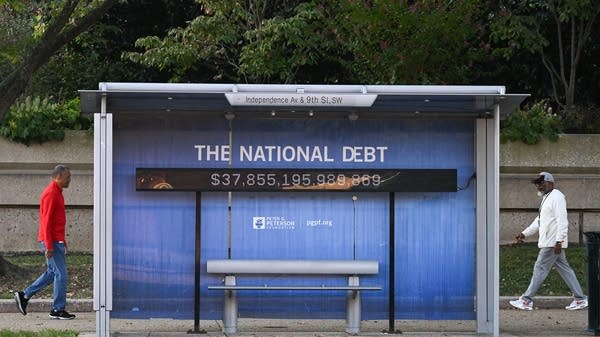How our $36 trillion debt came to be
A look back at the history of the national debt, and what the GOP’s new budget bill might mean for the debt going forward.

The GOP’s big tax and spending bill just passed the Senate, with a tie-breaking vote cast by Vice President JD Vance. Experts at the nonpartisan Congressional Budget Office say this bill alone will add more than $3 trillion to the national debt.
And it's not just the CBO saying that. Virtually every model from nonpartisan groups agree that this bill is gonna increase the debt — debt that stands today at $36.2 trillion.
Honestly, that’s an unfathomable amount of money. And sure, you know the broad strokes of it, but how did we get here?
To understand where the national debt comes from, you’ve got to go all the way back to the Revolutionary War:
“When Alexander Hamilton was Treasury Secretary, he proposed to assume the debts of the states in the Revolutionary War, and in doing so, significantly expanded the debts of the federal government,” said Eric Hilt, an economics professor at Wellesley College.
Debt itself isn’t bad — that’s really important to understand. Virtually every government has some.
Washington sells Treasury bonds to finance the difference between what it spends and what it takes in. The fact is, the government is responsible for things the private sector isn’t and it does things the private sector can’t.
Most noticeably when there's a crisis, like the Great Depression, Hilt said. President Franklin Delano Roosevelt granted half a billion dollars to help states, counties and municipalities care for those who needed “direct and immediate relief.”
Come 1941, the U.S. federal government would borrow money for national security purposes. During World War II, Americans were encouraged to invest every cent they could in war bonds, which added about $3 trillion in today’s dollars to the national debt.
“That's important to the country's survival,” said Carola Frydman, a professor at Northwestern University’s Kellogg School of Management.
Fast forward — a lot — to the crisis of 2007.
“The Great Recession required billions in bailouts or billions in assistance,” said Kathleen Day, a lecturer at Johns Hopkins Carey Business School.
“Making sure that banks survive was really important to keep the function of the economy in relatively good shape,” said Frydman at Northwestern.
The Great Recession added about $5 trillion to the debt in the 5 years after 2008, as the government created programs to help companies and small businesses and helped states pay for extended unemployment benefits.
All the bank bailouts — which I know you’re thinking about right now — just for the record? Those were repaid with interest.
At its most basic, there are just two parts to the debt equation: Revenue and spending.
The spending part gets a whole lot more airtime than the revenue part does, but the reality is revenue is really important. Or, rather, lack thereof.
Trump’s 2017 tax cuts weren’t the biggest ever, but they were plenty big. Just shy of $2 trillion was added to the debt.
By definition, tax cuts reduce revenue — revenue that’s needed for mandatory programs. In other words, spending required by law, which is the vast majority of what the government does.
And in fact, in 2018, after Trump cut taxes, the government spent about a trillion dollars more than it collected in revenue.
Then came the pandemic. We added $8 trillion to the federal debt between September 2019 and September 2022, to pay for stimulus checks, the paycheck protection program, and all those other COVID-19 benefits you probably remember. Which brings us to today.
The Congressional Budget Office said the GOP tax and spending bill will add $3.3 trillion to that pile of red ink. And it’s just math that the bigger our debt gets, the more expensive it gets. As Day at Johns Hopkins put it, “you’re charged interest on interest.”
“If you expand the debt a lot, it starts to expand itself unsustainably,” said Hilt at Wellesley. “And so it will just continue to expand on its own until you start to actually run budget surpluses and pay it down.”
The last time the U.S. ran a budget surplus was fiscal year 2001, under Bill Clinton.
The CBO said over the next decade, the GOP bill is going to add more than $400 billion just in interest payments to the national debt. As we’ve said before at Marketplace, no tax cut in the history of tax cuts has ever paid for itself.
The Senate bill goes over the House next. Speaker Mike Johnson said on Wednesday, they will put it to a vote.













